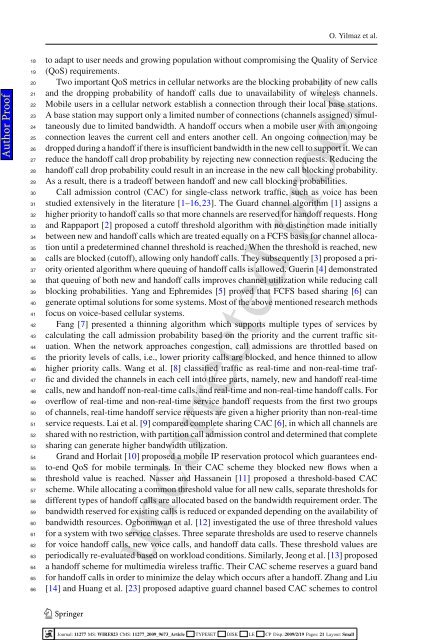Dear Author, Here are the proofs of your article. ⢠You can submit ...
Dear Author, Here are the proofs of your article. ⢠You can submit ...
Dear Author, Here are the proofs of your article. ⢠You can submit ...
- No tags were found...
Create successful ePaper yourself
Turn your PDF publications into a flip-book with our unique Google optimized e-Paper software.
O. Yilmaz et al.<strong>Author</strong> Pro<strong>of</strong>18192021222324252627282930313233343536373839404142434445464748495051525354555657585960616263646566to adapt to user needs and growing population without compromising <strong>the</strong> Quality <strong>of</strong> Service(QoS) requirements.Two important QoS metrics in cellular networks <strong>are</strong> <strong>the</strong> blocking probability <strong>of</strong> new callsand <strong>the</strong> dropping probability <strong>of</strong> hand<strong>of</strong>f calls due to unavailability <strong>of</strong> wireless channels.Mobile users in a cellular network establish a connection through <strong>the</strong>ir local base stations.A base station may support only a limited number <strong>of</strong> connections (channels assigned) simultaneouslydue to limited bandwidth. A hand<strong>of</strong>f occurs when a mobile user with an ongoingconnection leaves <strong>the</strong> current cell and enters ano<strong>the</strong>r cell. An ongoing connection may bedropped during a hand<strong>of</strong>f if <strong>the</strong>re is insufficient bandwidth in <strong>the</strong> new cell to support it. We <strong>can</strong>reduce <strong>the</strong> hand<strong>of</strong>f call drop probability by rejecting new connection requests. Reducing <strong>the</strong>hand<strong>of</strong>f call drop probability could result in an increase in <strong>the</strong> new call blocking probability.As a result, <strong>the</strong>re is a trade<strong>of</strong>f between hand<strong>of</strong>f and new call blocking probabilities.Call admission control (CAC) for single-class network traffic, such as voice has beenstudied extensively in <strong>the</strong> literature [1–16,23]. The Guard channel algorithm [1] assigns ahigher priority to hand<strong>of</strong>f calls so that more channels <strong>are</strong> reserved for hand<strong>of</strong>f requests. Hongand Rappaport [2] proposed a cut<strong>of</strong>f threshold algorithm with no distinction made initiallybetween new and hand<strong>of</strong>f calls which <strong>are</strong> treated equally on a FCFS basis for channel allocationuntil a predetermined channel threshold is reached. When <strong>the</strong> threshold is reached, newcalls <strong>are</strong> blocked (cut<strong>of</strong>f), allowing only hand<strong>of</strong>f calls. They subsequently [3] proposed a priorityoriented algorithm where queuing <strong>of</strong> hand<strong>of</strong>f calls is allowed. Guerin [4] demonstratedthat queuing <strong>of</strong> both new and hand<strong>of</strong>f calls improves channel utilization while reducing callblocking probabilities. Yang and Ephremides [5] proved that FCFS based sharing [6] <strong>can</strong>generate optimal solutions for some systems. Most <strong>of</strong> <strong>the</strong> above mentioned research methodsfocus on voice-based cellular systems.Fang [7] presented a thinning algorithm which supports multiple types <strong>of</strong> services bycalculating <strong>the</strong> call admission probability based on <strong>the</strong> priority and <strong>the</strong> current traffic situation.When <strong>the</strong> network approaches congestion, call admissions <strong>are</strong> throttled based on<strong>the</strong> priority levels <strong>of</strong> calls, i.e., lower priority calls <strong>are</strong> blocked, and hence thinned to allowhigher priority calls. Wang et al. [8] classified traffic as real-time and non-real-time traffi<strong>can</strong>d divided <strong>the</strong> channels in each cell into three parts, namely, new and hand<strong>of</strong>f real-timecalls, new and hand<strong>of</strong>f non-real-time calls, and real-time and non-real-time hand<strong>of</strong>f calls. Foroverflow <strong>of</strong> real-time and non-real-time service hand<strong>of</strong>f requests from <strong>the</strong> first two groups<strong>of</strong> channels, real-time hand<strong>of</strong>f service requests <strong>are</strong> given a higher priority than non-real-timeservice requests. Lai et al. [9] comp<strong>are</strong>d complete sharing CAC [6], in which all channels <strong>are</strong>sh<strong>are</strong>d with no restriction, with partition call admission control and determined that completesharing <strong>can</strong> generate higher bandwidth utilization.Grand and Horlait [10] proposed a mobile IP reservation protocol which guarantees endto-endQoS for mobile terminals. In <strong>the</strong>ir CAC scheme <strong>the</strong>y blocked new flows when athreshold value is reached. Nasser and Hassanein [11] proposed a threshold-based CACscheme. While allocating a common threshold value for all new calls, separate thresholds fordifferent types <strong>of</strong> hand<strong>of</strong>f calls <strong>are</strong> allocated based on <strong>the</strong> bandwidth requirement order. Thebandwidth reserved for existing calls is reduced or expanded depending on <strong>the</strong> availability <strong>of</strong>bandwidth resources. Ogbonmwan et al. [12] investigated <strong>the</strong> use <strong>of</strong> three threshold valuesfor a system with two service classes. Three separate thresholds <strong>are</strong> used to reserve channelsfor voice hand<strong>of</strong>f calls, new voice calls, and hand<strong>of</strong>f data calls. These threshold values <strong>are</strong>periodically re-evaluated based on workload conditions. Similarly, Jeong et al. [13] proposeda hand<strong>of</strong>f scheme for multimedia wireless traffic. Their CAC scheme reserves a guard bandfor hand<strong>of</strong>f calls in order to minimize <strong>the</strong> delay which occurs after a hand<strong>of</strong>f. Zhang and Liu[14] and Huang et al. [23] proposed adaptive guard channel based CAC schemes to controluncorrected pro<strong>of</strong>123Journal: 11277 MS: WIRE823 CMS: 11277_2009_9673_Article TYPESET DISK LE CP Disp.:2009/2/19 Pages: 21 Layout: Small
















